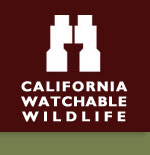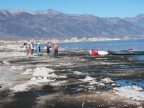

| Visitation: 250,000 | ||
| Area: 80,000 Acres | ||
| Lat: 53.2734 | ||
| Lon: | ||
| Nearby Services | ||
| Site Facilities | ||
| Join Our Mailing List |
|
For Email Marketing you can trust
|
Top Banner Photo Credits
Pam Starr
Alyn Robert Brereton
Julie MacKinnon
Linda Pittman
Parham Pourahmad
Larry Whiting
Randall Finley
Pam Starr
Alyn Robert Brereton
Julie MacKinnon
Linda Pittman
Parham Pourahmad
Larry Whiting
Randall Finley
© 2008-2024 California Watchable Wildlife and Blue Cat Studio, Inc.
| Mono Lake Tufa State Natural Reserve and Mono Basin National Forest Scenic Area - Site # 138 | |||
| Set in the high desert of the Eastern Sierra beneath snow-capped peaks, this vast inland sea is more than one million years old. | |||



| |||
| Background: | The lake is dotted with delicate calcium-carbonate knobs and spires called tufa. Brine shrimp and alkali flies thrive in water that is 2.5 times as salty and 80 times as alkaline as seawater, providing a feast for 70 species of migratory birds, including over one million eared grebes, Wilson's and red-necked phalaropes, and numerous shorebirds. The eastern shore is a major nesting area for snowy plovers, and the nesting islands attract 50,000 California gulls, their largest rookery in the state. This area is a Western Hemisphere Shorebird Reserve Network site. | ||
| The Visitor Center, South Tufa area, and the State Natural Reserve Boardwalk below the County Park provide interpretive panels and interactive exhibits to educate the public about the natural, cultural, and environmental history of the Mono Basin. The geologic history, evolution of the Lake's ecology, native American past, and the ranching and mining history are fascinating stories and readily available at these facilities. | |||
| The Habitat: | The Mono Basin is a sagebrush scrub landscape (80%), with pinyon/juniper woodlands along the foothills (5%). Near the lake, salt grass, sedges, and rushes dominate (15%) and surround the famous limestone formations known as tufa. Remnants of a fiery past surround the Basin, volcanic craters and pumice soil are readily accessible for visitors to explore. | ||
| The Experience: | Mono Lake and its surrounding watershed encompass a unique region in California. Sagebrush, Jeffrey pines, volcanoes, tufa towers, California gulls, eared grebes, brine shrimp, alkali flies, freshwater streams, and alkaline waters comprise an unlikely world at the transition between the Sierra Nevada Mountains and the Great Basin Desert. Great Basin spadefoot toads fill the evening air with an endless chorus of croaking while Nighthawks hunt for insects in the fading twilight. Trillions of brine shrimp eat and mate beneath the briny waters of Mono Lake as Wilson's Phalaropes feast on alkali flies in preparation for their non-stop flight to South America. Embracing 14 different ecological zones, over 1000 plant species, and roughly 400 recorded vertebrate species within its watershed, the Mono Lake basin encompass one of California's richest natural areas. It is part of the Eastern Sierra Scenic Byway. | ||
| Wildlife and Where to Find It: | Opportunities to view wildlife from cars are available in several locations, inquire at Visitor Center. Several miles of trails in the Mono Basin provide visitors with a range of opportunities to view wildlife. Trails vary from easy to strenuous. Wildlife viewing by boating is available, there are put-ins in several locations around the Lake. All boaters should obtain safety and regulatory information at the Visitor Center. | ||
| Viewing Tips: | Birding peaks in summer but is done year-round, photography is popular year-round, boating is available during the summer and fall. | ||
| Site Notes: | The strange waters of Mono Lake and puzzling geologic formations of the Mono Basin form a giant landscape comparable to none. The lake mirrors the surrounding mountains and reflects the soft hues of the desert landscape, the striking peaks of the Sierra, and the brilliant blue sky. A photographer's dream, a geologist's wonder, and a birder's paradise, all will be awed by the amazing scenery and are sure to find solitude and peacefulness in the vast Mono wilderness. | ||
| Nearby Viewing Sites: | Mono Lake Tufa State Natural Reserve and the Mono Basin National Forest Scenic Area have a number of places that visitors can explore, enjoy, and watch for wildlife. Stop by the visitor center to obtain maps and directions. To the south in Bishop, Fish Slough Area of Critical Environmental Concern is an official viewing site. | ||
| Festivals & Events: | Mono Basin Bird Chautauqua Owens Lake Bird Festival | ||
| Visitor Information: | Mono Lake Committee - (760) 647-6629 - monolakecommittee.org | ||
| Viewing Site Hours of Operation are: | |||
| Staff On-site: | Yes | ||
| Open: | Everday | ||
| Hours: | Visitor Center hours vary, call for current status | ||
| Year Round: | Yes | ||
| Seasonal: | The Mono Basin National Forest Scenic Area Visitor Center is open April through November, hours vary. The islands of Mono Lake are closed from April 1 to August 1 to protect nesting gulls. | ||
| Road Information: | |||
| Road Hazards: Soft sand | |||
| Parking Fee: No | |||
| Proximity to viewing area:varies | |||
| Parking Notes: People are discouraged from pulling off the road except in designated areas. | |||
| How to Get There: | Multi-agency visitor center just north of Lee Vining off Highway 395. South Tufa Area: From Lee Vining, travel 5 miles south on Hwy 395 and turn east on Hwy 120. Travel 5 miles east to the South Tufa turnoff on the north side of the road. Follow the dirt road to the parking lot. | ||
| Contact Information | |||
| Managing Agency: | USDA Forest Service, Inyo National Forest | ||
| Agency Site URL: | http://www.fs.usda.gov/recarea/inyo/recarea/?recid=20620 | ||
| Physical Address: | 1 Visitor Center Drive Lee Vining, CA 93541 |
Agency 2: | 1 Visitor Center Drive Lee Vining, CA 93541 |
| Manager Phone: | |||
| Site Phone: | USFS (760) 647-3044 - CSP (760) 647-6331 | ||
| County: | Mono | ||
| Addition Website: | http://www.parks.ca.gov/?page_id=514 | ||
